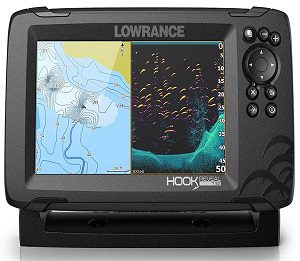 A Fish Finder is a device or equipment that is widely used nowadays to catch more fish by finding more promising fishing locations. As the name itself reflects, it provides ease in searching for particular fish and structures underneath the water. Plus, It makes use of sound energy pulse deflections underwater for its detection.
A Fish Finder is a device or equipment that is widely used nowadays to catch more fish by finding more promising fishing locations. As the name itself reflects, it provides ease in searching for particular fish and structures underneath the water. Plus, It makes use of sound energy pulse deflections underwater for its detection.
Furthermore, a fish finder facilitates a fisherman with an opportunity to view the underwater depth, structure, speed, structure, any hiding spots along with the temperature of the water column. Fishfinder displays generally use sonar signals. The signals provide clear visual images of moving and still objects beneath the water.
Lowrance is among one of the best manufacturing companies for marine fish finders and other gadgets that provide you ease in the water. The Lowrance fish finders are specifically designed to help you grab the fish, regardless of whether you are a beginner or a pro. Lowrance has to offer a versatile range of items for fish lovers. In order to optimize its use, it would be better to learn how to use it.
Learn how to use a Lowrance fishfinder in 4 easy steps
After you unbox your new Lowrance device, read through the instructions manual to get an idea about what goes where. This article would help you learn how to use the Lowrance fishfinder device. We have summarized the process of using a Lowrance fishfinder into four easy steps.
Go through the default settings
Start with spending a few minutes in the water to see how exactly the default settings work and how you want to set them. This will help you in learning how to use Lowrance sonar. Once you are in the water, the simulator mode will automatically load. After that you will be able to see the default menu, click on the menu and focus on what each symbol and value mean.
Now look closely, you would see the reading of numbers and values in the upper left corner of the fish finder display screen. This tells the depth of the water is right underneath your boat.
If you prefer to get perfect results, Don’t forget to make sure that the automatic mode is on. You might see the boat speed and water temperature based on the particular model of your device on the display, but if consider looking at the bottom area of the screen, you will notice a line that extends from one side of it to the other. This line shows the bottom of the sea, lake, river, or ocean on which you are boating.
Read your display screen
Now read the objects shown just above the line, this will probably give you some idea about the type of objects present beneath the water. On the other hand, timber or trees growing on the bottom will show up in a form of vertical lines on the screen of the Lowrance fishfinder device. The aquatic vegetation will be shown as thicker and with a bit more pronounced icons.
Plus, It is very important to learn about the Down scan feature which provides help in enhancing your whole experience. Why? well, because the down scan feature focuses a lot more on the object than its surroundings. It also integrates a full cone that helps to reveal targets. This feature of the Lowrance fishfinder makes the Lowrance down scan better than the 2D Sonar.
Get familiar with side screen
As per many fishermen and anglers, finding fish with the help of a side-scan can turn out to be an awful experience, just simply because the boat doesn’t have enough display screen. Therefore, anglers try to select the sonar, map, and down scanning while ignoring side scanning. Well, the process of finding fish could be quite easy if done considering the right conditions.
Among other problems with side-scanning, this one bothers the most, a rocky bottom in side-scanning reflects so massively that it becomes very easy for the fish to hide. So, when softer bottoms reflection appears, you can easily see and spot those fish. Surprisingly, the Lowrance 3D Structures can also be used to catch suspended crappie. It has a 3D display that actually works like a side-scan but only allows you to see to the point where the fish are visible to see.
Focus on water column
If you try to look for fish in the water column between the two lines present on the bottom and at the top. Icons that look like arches or represent fish. The size of the icon indicates the size of the fish under the water.
Pay close attention to what direction in the water column the fish are exactly moving. See whether they are right on the bottom or just near your boat. Also, keep in mind that fish generally look quite significant at a depth range of 20 feet as compared to the depth range of 100 feet.
- What Do You Need for Fishing - August 18, 2022
- How to Find Offshore Fishing Spots - August 18, 2022
- What to Use for Trout Fishing - August 17, 2022
